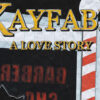It did take a bit of time, but Laura Nyro, the artist that was posthumously inducted into the Songwriters Hall of Fame in 2010, and into the Rock and Roll Hall of Fame in 2012, is finally getting a box set titled American Dreamer that covers the key period in her career cut short by her untimely death from ovarian cancer back in 1997.
While Nyro’s name may raise eyebrows even with some of the most ardent followers of music, the artists that covered her music (and had big hits with them) ― and an even wider swath of musicians and critics ― count her as one of the most influential artists around .
After all, as Sam Sodomsky notes in his review of the upcoming box set, she was “only 19 when her debut album was released in 1966, she soon became famous for writing hits for other artists—one week in November 1969, three of the Top 10 songs in the country were her compositions, as interpreted by the 5th Dimension, Blood, Sweat and Tears, and Three Dog Night.
“Like so many of them, Nyro’s greatest legacy is in the wide range of artists she influenced: Joni Mitchell was inspired by her inventive piano playing; Elton John found his voice within her detail-rich songwriting; both Todd Rundgren and the members of Steely Dan took early influence from her jazzy, meticulous melodies; Bette Midler wanted to sing like her; Miles Davis and Alice Coltrane spent studio time alongside her.”
So, where did the magic music and influence of Laura Nyro come from and what is the legacy she left after her untimely death?
The Girl From the Bronx Invents Her Words
Nyro was born in the Bronx, New York in 1947 as Laura Nigro. Her last name change actually is telltale of her joy in playing with, even inventing words. And she was not only great at doing it, but now counts as one of the most inventive songwriters to work with both lyrics and music.
Back in 1969 Nyro named one of her best albums New York Tendaberry. As explained by those more in the know, New Yorkers from the Bronx, Queens, and Brooklyn have their own dialects and many tend to slur over or eliminate altogether the letter R when it’s at the end of a word. And it seems that is exactly what Nyro was trying to say. In her own way, in her own terms.
As she explained in an interview to Billboard, “I’ve created my own little world, a world of music since I was five years old. I was never a bright and happy child.” It is something that was always present both in her music, but also in its presentation. As Sodomsky notes, when she auditioned as a teenager for Clive Davis at Columbia Records, she sat at the piano and didn’t take to the lighting in his hotel room. Instead, she requested total darkness, with just the television on, so that its glow would light the room. “What might have seemed like an eccentricity turned out to be a keen awareness of the most natural environment for her music.”
In that work she created, Nyro picked up her musical influences ― girl group soul, gospel blues from Leontyne Price and Nina Simone to Billie Holliday, but also equal doses of classical music, particularly French impressionist composers like Debussy and Ravel, from whom she picked up the unusual melody and time signatures that often would shift a few times within a single song.
Definitely More Than Just Another New (Musical) Discovery
As a teenager, Nyro started using various surnames. It just so happened that when she began recording her debut album More Than Just A New Discovery (1966), Laura was using Nyro a variation of the one at birth, as her surname, and it just stuck.
If there ever was an apt album title, this was it. After all, on it Nyro recorded some of her classic songs like “Stoney End” (a hit for Barbara Streisand), which boasts the stunning opening line:
I was born from love, and my poor mother worked the mines
– “Stoney End”
I was raised on the good book Jesus till I read between the lines
But as if that was not enough, the album included gems like “Wedding Bell Blues” and “Time and Love.” It also included, “And When I Die,” one of her most re-recorded songs, a hit for both Peter, Paul & Mary, folk heroes of the ’60s and Blood, Sweat & Tears, who actually at one point asked Nyro to be their lead singer. Nyro was dissuaded by her then-manager, one David Geffen.
The album was a critical success, and although it did not create much commercial buzz, Nyro was invited to play the now-legendary Monterey Pop Festival, in mid-June of 1967. It was a seemingly controversial performance, as some dubbed it as a fiasco, but later publicly available recordings seem to contradict these versions.
Whatever happened at Monterey, what came afterwards was probably Nyro’s most creative period as a recording artist. What Geffen was able to do is give one thing Nyro craved the most ― complete artistic freedom, something quite out of the ordinary with the big record labels at the time like Columbia/CBS.
An Immaculate Trilogy
The trilogy of albums that followed, Eli and The Thirteenth Confession (1968), New York Tendaberry (1969), and Christmas and the Beads of Sweat (1970) all rank among most all-time modern music classic list. It is hard to call that music singularly either, pop, rock, gospel or avant-garde jazz as it is all of those combined together.
While the first two of these albums were practically all Nyro, Christmas and the Beads of Sweat was a dual affair, where the first side was her vision of soul music recorded with the seasoned Muscle Shoals music crew that included Duane Allman on guitar; the second side was Nyro reaching into the realms of spiritual jazz, with the sessions including Alice Coltrane and her inimitable harp.
Gonna Take A Miracle (1970) which followed was Nyro’s take on her favorite sounds of female vocal groups, where she was backed by Labelle (Patti Labelle, Nona Hendryx, and late Sarah Dash), one of the best female soul groups of any time.
What followed this was a series of events that were so characteristic to Nyro as a person. In 1971, David Geffen started forming his own record label. Actually the money he did it with came from the sale of Tuna Fish Music, his joint company with Nyro to CBS. The sale took place in 1969 and Geffen and Nyro got a then whopping $4.5 million (each got half). Geffen wanted the company to expose the talent he managed, including Nyro and Jackson Browne (Nyro’s private life partner at the time).
But, at some point, just before she was to sign the recording deal with Geffen, Nyro changed her mind and re-signed with CBS without telling Geffen, and by the end of that year she was married to carpenter David Bianchini. While also publicly announcing she was retiring from the music business. The reason: she simply didn’t want to be marketed as a celebrity.



Times Change and Illness Sets In
Five years late (1976), Nyro was out of her marriage and back in the studio, resulting in a new album of original material titled Smile. Never a comfortable live performer, she went on a months-long tour which resulted in the live album, Season of Lights (1977).
Nyro recorded three more studio albums Nested (1978), Mother’s Spiritual (1984), and Walking The Dog Late At Night (1993). While somewhat neglected by both fans and critics, all of these albums included enough of her lyrical and songwriting touches to make them rise above the standard of the time. The last of the three actually was the initial spark of reappraisal of her complete oeuvre.
Nyro’s personal life was something she tried to keep as private as possible, but being popular in any degree usually doesn’t make that possible. While she was in a relationship with Browne, married to Bianchini and had a child from a brief relationship with Harindra Singh, since the early ’80s she began living with painter Maria Desiderio, with whom she spent the rest of her life until her untimely death in 1997. It was during that period that Nyro became an active participant in the feminist cause.
In retrospect, even with her untimely departure, and lack of personal success some of her songs acquired with other artists, Laura Nyro’s influence remains undiminished and the new box set goes on to confirm that fact. After all, personal success was something that Nyro wasn’t really after. She deserved it though.





